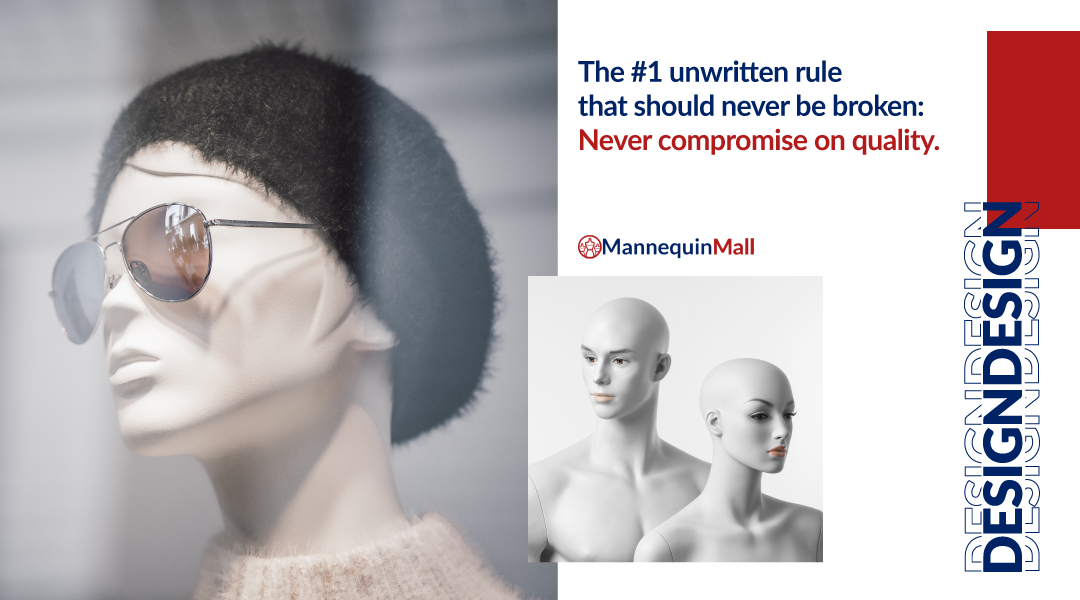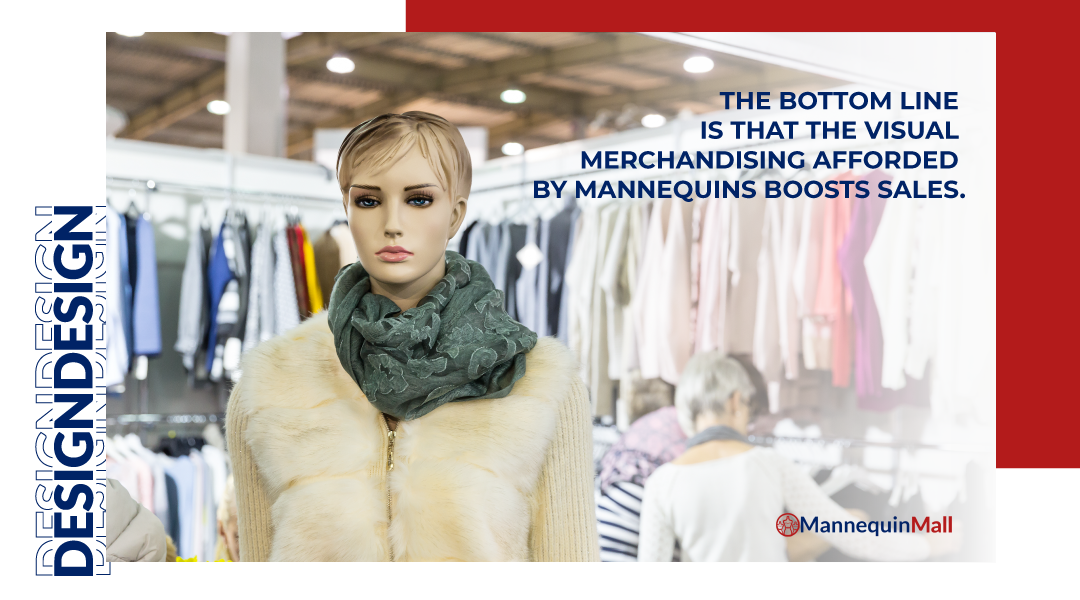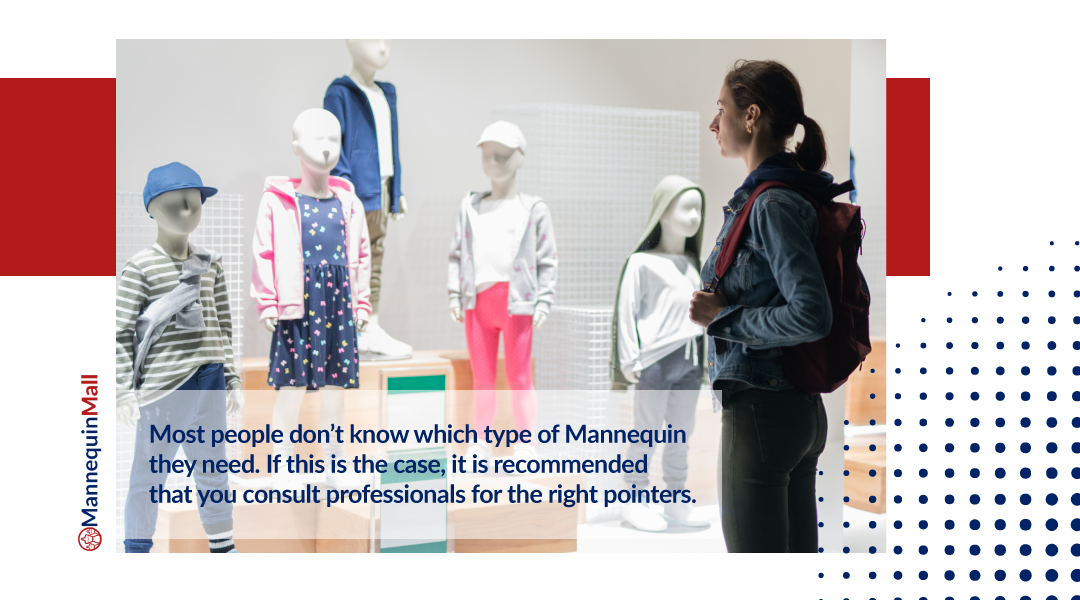Your Cart is Empty
Our office and phone lines will be closed for the holidays until January 2. Happy holidays!
Our office and phone lines will be closed for the holidays until January 2. Happy holidays!
Our office and phone lines will be closed for the holidays until January 2. Happy holidays!
Our office and phone lines will be closed for the holidays until January 2. Happy holidays!
April 15, 2020 10 min read

Visual merchandising is the king in the apparel, footwear, jewelry (and any setup that deals with wearable merchandise) business. It gives customers a clear picture of how they would look like in your merchandise. It lures them even before they try the products on. And, while visual merchandising ideas are evolving, mannequins are still the popular option.
Clothing stores, pop-up stores, jewelers, fashionistas, and professional merchandisers have been using mannequins for over a century. Their human form makes for the ideal visual merchandising medium. However, it takes more than just another mannequin to leverage the benefits of visual merchandising – it takes the right mannequin in aspects such as appearance, style, and more! Fortunately, mannequins have evolved to almost become realistic.
So, how do you go about buying the ideal mannequin for your needs? This guide answers your questions and gives you a more in-depth, broader insight into how mannequins work.

First: An Overview of Mannequin Types & Styles
Mannequins come in all shapes, colors, and sizes. However, they can all be categorized into four types:
Full-Body Mannequins
Full-body mannequins feature all parts, from head to toe. They come in varying shapes, colors, and sizes. The high-end makes are realistic-looking as they are designed to mimic the effect of a real-life model. The simpler ones come with few details, except for basic body form.
Ghost Mannequins
Ghost mannequin is one of the many points where technology meets fashion. They are named so because clothes appear to be moving or floating when dressed. This is made possible by the use of a raster graphics editor. The editor is a computer program used to create interactive images, such as a person dancing or moving. It comes very close to having a real-life model as the mannequins are very versatile–virtually every body part can be moved.
Dress Form Mannequins
You can think of body dress forms as the analog version of ghost mannequins–they are flexible and versatile but in a limited way. These mannequins are capable of adjusting to the size and shape of a clothing article. They are made of canvas, which allows designers to alter their size and shape as needed when designing and displaying clothing.
Stand-Alone Mannequin Parts
It takes different parts to make a full-body mannequin. These parts can also be presented alone as stand-alone mannequins. They can be torsos for displaying upper-body clothes, legs for displaying pants, necks for displaying necklaces, or heads for displaying mannequin wigs (and virtually anything else you can think of).

10 Factors to Consider When Shopping
Every aspect of a mannequin and its use matters. Following are ten factors to consider when shopping for one:
What do you intend to do with the manikin, or what line of business are you in? If you are in fashion and clothing, you may need full-body mannequins to display your range of products. If you are a jeweler, all you may need are stand-alone parts such as arms and necks to display your jewelry pieces. If you are a fashionista and travel a lot, then you will need a durable and formidable mannequin that can withstand the stress of traveling.
The point is that every aspect of your business determines the type of mannequin you should get. As such, ponder about this thoroughly before buying.
As mentioned, your customers picture themselves wearing your merchandise. They want to know how they would look like with whatever you have to sell–you must have had experience with those customers who try on dozens of clothes, right? They also want to know how they will feel in your merchandise. Will they feel as glamorous as that flawless mannequin in a modeling pose? Will they feel as strong and as athletic as that action-posed mannequin showing off your sportswear?
You should satisfy their curiosity the minute they walk into your store by using mannequins that represent them. So, how do most of your customers look? What look and experience are they looking for when they visit your store? What merchandise is primed to fly off the hangers if you create enough buzz?
If you specialize in merchandise for the young, then a variety of child mannequins is appropriate for your window displays. If you run a sportswear boutique, then your mannequin display should look like athletes and strike a pose. And, if you manage a general retail store, then you should get a male and female mannequins for every section of your store.
There are several factors to consider in this case: color, size, gender, and more! Make sure that you get everything right and try to be as inclusive as you can.
Remember: appearance is everything when it comes to visual merchandising and looks is where most uninformed people go wrong. Your customers will be turned off if they can't instantly identify with your mannequins, no matter how good your merchandise is!

What comes to mind when people see your store or think of your brand? How do you see your store, ideally?
Every aspect of your store, both little and big, contributes towards your brand’s image. It starts with the kind of merchandise you sell.
The store’s setting and layout also matter (this is the foundation of visual merchandising).
And, in this case, the mannequins matter a lot too. They should communicate your brand’s story as clearly as possible–take time to pick the right size, shape, color, poses, material, and even consider custom orders to include other brand elements as appropriate.
While the factors may vary, however, there is one unwritten rule that should never be broken: never compromise on quality. Even if you deal with cheap, second-hand clothes, a great presentation of your best pieces will keep customers coming back.

Each mannequin type serves a specific purpose, so the one you choose will largely depend on your line and nature of business. And, as mentioned, each type of mannequin has its benefits and shortcomings.
For instance, a clothes store retailer dealing in all clothing types would be better off with a full-body mannequin as they can display multiple clothing articles and thus get your customers to buy more items.
Half body mannequins are great for displaying tops and other accessories in the middle of larger clothing displays.
A stand-alone, such as a mannequin torso, legs, or mannequin head display, will also come in handy if you specialize in pants, shirts, or wigs – they also come in handy when you have limited space to work with.
Tip: Many smart business people don’t know which type of mannequin they need. There is no need for embarrassment If this is the case, it is recommended that you consult professionals for the right pointers.
Mannequins are made of a wide range of materials. The most common material is plastic, but metal, wood, canvas, fiberglass, and carbon fiber are also popular.
Each material has its benefits and shortcomings. For instance, a metallic mannequin is durable but also heavy, which makes it difficult to move around – it wouldn’t be ideal for fashionistas who take their show on the road.
A plastic mannequin, on the other hand, is light and flexible, but it is also delicate and requires extra care to avoid ruining it–and, as you remember, presentation is everything with mannequins.
Mannequins can strike a pose, can’t they? That is what they are made for. However, some remain in one fixed posture (static), while others are capable of changing styles (flexible).
It seems a no-brainer that anyone would go for a flexible mannequin over a static one. Flexible mannequins are easy to work with, as they can be positioned to bring out the merchandise’s best qualities. Some mannequins are incredibly flexible, as virtually all limbs can be moved to replicate even complicated poses.
Static mannequins have their benefits too. They are ideal for selling merchandise that does not require complex settings to market, such as handbags and jewelry. Their static nature also makes them more durable than flexible ones–the latter need a higher degree of maintenance to ensure longevity.

Fashion has always been at the forefront of challenging what is considered to be normal. While not without points of earned criticism, the growth of diverse representation in visual merchandising is a positive force that won't be disappearing. While we await the mass adoption of differently-abled mannequins, more and more stores are finding a diverse array of displays is a positive influence on their customer engagement.
From a buying perspective, this includes the type (like we mentioned before) but also size and color.
When it comes to color, try to have a mix of colors that represents both the story of your display and the characteristics of your audience. When mannequin buying, you will find that colors tend to come in both primary and fleshtone colors, so try to make sure you have a variety. If possible, everyone who walks through the door should feel like they can relate to your store display.
Necessity dictates when it comes to size. Many successful stores are selling plus-size merchandise, and they use plus-size mannequins for marketing their products. If you sell plus-size clothes, then be sure to buy a few plus-size mannequins. Take the same time to create an active scene with your plus-sized displays as you do in other displays. Remember, it's about helping each diverse person participate in your brand story.
Inclusivity is critical in today’s society and especially in the clothing industry, since most people judge others by their appearance. Be proud of your diversity and highlight different forms together to bring in customers from all backgrounds.
How often will you be moving your mannequin? Will you be taking it on the road to different destinations, or will it sit in your store all day?
Ideally, mannequins should be light. However, some of the materials that are considered more durable (the metal stand or metal base for your favorite display mannequin) will tend to be heavy. This should not be much of a problem if your mannequins will sit in one place for most of the time. However, it will be a setback if you do a lot of traveling and take your mannequins with you.
If travel is your main focus and you need display forms for your next tradeshow, consider a mannequin head or other parts made of styrofoam. It's light, cheap and looks amazing when customized to display your best sellers on your countertop.
Tip: If you are looking for a mannequin that is both durable and light-weight (easily portable), go for one made using carbon fiber. It might be more expensive, but the material is tough and light–it's good-looking too!

Running a business is a lot of work! There are clothes to arrange and style, stuff to clean, employees to manage, and so much more! It wouldn’t help to get mannequins that would only increase your chores, right?
Some mannequins are easier to maintain compared to others. For instance, static mannequins don’t need much work save for a little cleaning. In contrast, flexible mannequins need more than just cleaning as the movable joints have to be protected or else they will get loose. Glass mannequins are elegant but fragile and should be handled with utmost caution.
The extra work that comes with maintenance shouldn’t be a cause for concern if you are willing to go the extra mile to increase your sales. If, however, your mannequins need special maintenance, then ensure that you do it by the book to prolong their durability. You should feel comfortable reaching out to your preferred mannequin retailer or manufacturer for assistance in understanding your mannequin's maintenance needs.
How much money do you have to work with? Mannequins are generally cheap, but some of the high-quality, realistic mannequins are quite expensive.
The most expensive mannequins are usually the best-looking, but the fact is that not everyone can afford them. As such, consider your budget and stretch it as thin as you can. The only rule is to avoid poor-quality, substandard mannequins–they will cost you more than you pay for in the end. If circumstances force it, then get a few expensive mannequins and fill the shortage later when you get more money.
Your store’s space and setting are also factors of consideration. Avoid using too many mannequins such that your store will look cluttered instead of enticing. Additionally, ensure that the mannequins are strategically positioned to capture the customers’ attention.
Why Use Mannequins? – The Benefits
The global footwear and apparel industry is worth about $1.5 trillion, and the figure has been rising steadily over the years. There is a lot of money to be made, but there is also a lot of competition. To stay ahead of the competition, smart visual merchandisers leverage the power of smart visual strategies, chief among them are mannequins.

So, how are mannequins helpful? Here are four key benefits that attest to these dummies’ importance:
It would be easier to notice apparel on a mannequin than on a rack. It would also be easier to convince a customer looking for a shirt to get a pair of pants, too, if they go well with the shirt on the mannequin. The bottom line is that the visual merchandising afforded by mannequins boosts sales. Potential customers don’t need to do too much imagining to picture your merchandise on themselves, and it will take less convincing to get them to buy.
With the cut-throat competition currently in the market, anything that boosts sales should be a welcome addition.
Mannequins may be nothing but dummies, but they look and feel somewhat real to most of the people who walk through the door. They command attention with their striking poses and life-like features. They also look good under the light. To this end, a store featuring mannequins looks and feels livelier than one that doesn’t.
A store that doesn’t feel alive won’t stay alive for much longer. Besides, fashion is the line of business where looks matter the most.
Mannequins bring out new ideas on how to style and couple your merchandise. They inspire store owners to go that extra mile and stand out from the competition. Displaying mannequins may give you insights into new settings and designs that will increase customer spending.
Mannequins come with varying price tags, and some are expensive. However, the cost of a mannequin can continue to provide value year after year. Most companies see a positive ROI on their visual merchandising in the form of increased traffic and sales.

The Brief, Interesting Back-Story
Mannequins are so popular that they have inspired a huge social media fad: #mannequinchallenge. It turns out that they have been popular for close to two decades since they were first conceptualized in the 1870s. Back then, they were made of wax and featured realistic replicas of human parts, including fake teeth and hair – they were so controversial that there was a law requiring store owners to cover the mannequins before undressing and changing them.
Mannequins have come a long way over time. They have inspired the rise of celebrities such as Lester Gaba and have inspired Box Office movies such as Mannequin. They have also become more sophisticated and functional, as covered above.

Shop Smart!
So, are you finally sold on the need for mannequins? Are you asking yourself, “where can I buy a mannequin?” Look no further than here!
Smart retailers from all over come to us to supply them with the ideal mannequins for their various needs. We work with different lines of business, including apparel retail, jewelry, fashionistas, event planners, and more! We stock a wide range of mannequins of all types, and all styles, colors, and sizes are covered.
Our mannequins are good-looking (almost as good as you) and of superior quality. Get in touch today to learn more about our products and browse our vast inventory!
Comments will be approved before showing up.